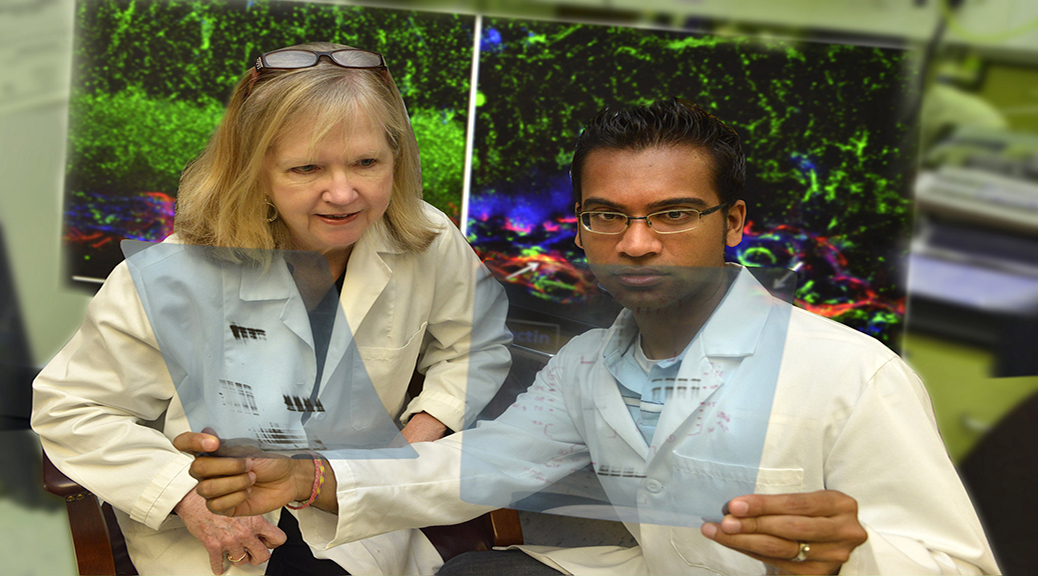A gene known to play a major role in constricting blood vessels also appears to be a major player in the aberrant blood vessel growth that can destroy the vision of premature babies such as in Retinopathy of Prematurity and possibly in Diabetic Retinopathy.
 |
| (c) Georgia Regents University & Health System |
This gene expression (endothelin) is noticed to be greatly increased in the retinal tissue of a mouse model of retinopathy of prematurity, according to researchers at the Medical College of Georgia at Georgia Regents University, who published a paper in The American Journal of Pathology. The finding points toward a new therapy to help prevent the damage as well as a broader role for endothelin, known as a powerful blood pressure regulator, which also appears to have a role in blood vessel formation.
Despite long-standing strategies to give premature newborns the lowest oxygen therapy possible to protect fragile, immature tissues such as the retina while providing adequate support to vital organs, vision damage remains an ongoing concern in neonatal intensive care units.
In addition to immediate impacts on vision, the condition increases a child’s risk of retinal detachment, nearsightedness, crossed eyes, lazy eye, and glaucoma.
The retina, in premature babies, is not yet ready to function, since there is a lack of formed blood vessels throughout the tissue. Oxygen therapy, necessary to support other organs, further slows blood vessel development, which leads to retina becoming ischemic. Neurons and supporting cells start secreting proteins and growth factors to try to recuperate from the lack of oxygen and nutrients to these areas, which instead, leads to formation of leaky, malpositioned blood vessels.
There are a number of other things happening at the same time, such as high-oxygen levels that increase the levels of oxidative stress, which in turn increases inflammation in the face of decreased production of growth factors needed to produce healthy blood vessels. Blood vessels start growing in every direction, including on top of each other, termed neovascularization.
Protruding blood vessels can create enough stress to actually detach the retina, the main cause of visual impairment and blindness from retinopathy of prematurity, according to the National Eye Institute. Vascular endothelial growth factor, which is essential to neuron growth, is considered a primary culprit in retinopathy of prematurity as well as diabetic retinopathy, in which it contributes to a similar problem with erratic, leaky blood vessel growth that obstructs vision.
In their animal model of retinopathy of prematurity, mice born at term were given high-oxygen levels seven days later, which destroys some of the vessels that have developed and essentially halts the development of new ones as the immature retina continues to develop. They note that even at term, mice eyes remain shut for a few weeks because, as with premature babies, they are not yet ready to function.
Cell sensors that keep up with oxygen exposure, sense too much oxygen and stop growing, so blood vessels don’t form. The return to being given normal air seems like oxygen deprivation by comparison, so, similar to what happens in diabetic retinopathy where retinal blood flow is compromised, mice start growing many, obstructive blood vessels.
When the scientists looked at gene expression in retinal tissue five days after the return to being given normal air – considered the peak period of dysregulated blood-vessel growth – they found about a 50-fold increase in the expression of endothelin 2, a potent blood pressure regulator and blood vessel constrictor in normal conditions, and about a three-fold increase in endothelin 1, also a constrictor. There was also a significant increase in endothelin receptors.
While other genes, including VEGF, had increased expression, endothelin’s was the most dramatic and indicates its role in blood vessel formation. The scientists don’t yet know if it’s a direct effect or secondary to its role in blood pressure regulation. Although the emerging role of endothelin in cancer, where it appears to help tumors survive, indicates a direct one.
Anti-VEGF therapy is often given for diabetic retinopathy and more selectively for retinopathy of prematurity. However, the scientists note that there is increasing evidence that other potential factors may also need regulating, such as endothelin. When the scientists gave endothelin receptor blockers, already used to treat other conditions, to the mice prior to the peak period of dysregulated growth, they helped normalize blood vessel growth.
Next steps could include seeing if an endothelin antagonist will also work to correct dysregulated growth after it has occurred and packaging it with anti-VEGF therapy.
The research was supported by the National Eye Institute, the Department of Veterans Affairs, the American Heart Association, and the GRU Culver Vision Discovery Institute.
No comments:
Post a Comment
Thanks for your comments. We will get back to you shortly if there is a need to respond to it.
- Admin, Retina Global
Read more on Retina Global.